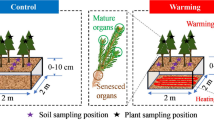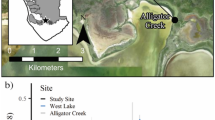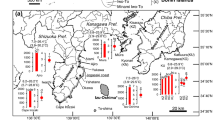Abstract
Eichhornia crassipes is a noxious weed and is cold sensitive. Water level treatments may affect its overwintering and regrowth capability during warming winter. To test this hypothesis, an experiment was conducted to analyze the effects of different water levels on the survival rates and regrowth of E. crassipes under experimental warm winter conditions. Three water levels were set up including drawdown with rooted, shallow submergence with rooted and floating. Regrowth characters including number of ramets, Fv/Fm, biomass and biomass allocation were surveyed. The results showed that warming significantly increased survival, ramet numbers and the biomass of plants. Warming also significantly increased Fv/Fm in drawdown plants. Water level only impacted plants under warming conditions. Compared to floating plants, drawdown significantly decreased survival but increased total biomass, while submergence led to 100 % survival, significantly higher ramet numbers and increased total biomass. In terms of biomass allocation, the effects of warming were similar for drawdown and submergence cases; it resulted in increased shoot biomass allocation and a lower root mass ratio. Warming only significantly increased the stem mass ratio of floating plants. Our findings suggested that warming help E. crassipes successfully overwinter and regrow during the next growing season. Drawdown or shallow submergence cannot effectively control this species but rather promotes its regrowth during warm winters. Thus, this species has the potential to spread with warm winters and frequent water level fluctuations caused by future climate change.



Similar content being viewed by others
References
Abbasi SA (1998) Weeds of despair, and hope. In: Abbasi SA (ed) Wetlands of India, vol 3. Discovery Publishing House, New Delhi, pp 2–21
Abbasi SA, Nipaney PC (1986) Infestation by aquatic weeds of fern genus Salvinia: its status and control. Environ Conserv 13:235–241
Allen M, Raper S, Mitchell J (2001) Uncertainty in the IPCC’s third assessment report. Science 293:430–433
Arnell NW, Reynard NS (1996) The effects of climate change due to global warming on river flows in Great Britain. J Hydrol 183:397–424
Baker NR (2008) Chlorophyll fluorescence: a probe of photosynthesis in vivo. Annu Rev Plant Biol 59:89–113
Barko JW, Gunnison D, Carpenter SR (1991) Sediment interactions with submersed macrophyte growth and community dynamics. Aquat Bot 41:41–65
Barrett SCH (1980) Sexual reproduction in Eichornia crassipes (water hyacinth) II. Seed production in natural populations. J Appl Ecol 17:113–124
Blom CWPM, Voesenek LACJ (1996) Flooding: the survival strategies of plants. Trends Ecol Evol 11:290–295
Carignan R (1982) An empirical model to estimate the relative importance of roots in phosphorus uptake by aquatic macrophytes. Can J Fish Aquat Sci 39:243–247
Cooke GD (1980) Lake level drawdown as a macrophyte control technique. Water Res Bull 16:317–322
Ding YH, Guo GY, Zhao ZC, Xu Y, Luo YL, Li QP, Zhang J (2007) Detection, attribution and projection of climate change over China. Desert Oasis Meteorol 1:1–10
Dugdale TM, Clements D, Hunt TD, Butler KL (2012) Survival of a submerged aquatic weed (Egeria densa) during lake drawdown within mounds of stranded vegetation. Lake Reserv Manag 28:153–157
Dugdale TM, Clements D, Hunt TD, Butler KL (2013) Survival of cabomba (Cabomba caroliniana) during lake drawdown within mounds of stranded vegetation. Lake Reserv Manag 29:61–67
Fan SF, Liu CH, Yu D, Xie D (2013) Differences in leaf nitrogen content, photosynthesis, and resource-use efficiency between Eichhornia crassipes and a native plant Monochoria vaginalis in response to altered sediment nutrient levels. Hydrobiologia 711:129–137
Fan SF, Yu HH, Liu CH, Yu D, Han YQ, Wang LG (2015) The effects of complete submergence on the morphological and biomass allocation response of the invasive plant Alternanthera philoxeroides. Hydrobiologia 746:159–169
Gopal B (1987) Water hyacinth. Elsevier, Amsterdam, p 471
Harley KLS (1990) The role of biological control in the management of water hyacinth, Eichhornia crassipes. Biocontrol News Inf 11:11–22
Heard TA, Winterton SL (2000) Interactions between nutrient status and weevil herbivory in the biological control of water hyacinth. J Appl Ecol 37:117–127
Hellmann JJ, Byers JE, Bierwagen BG, Dukes JS (2008) Five potential consequences of climate change for invasive species. Conserv Biol 22:534–543
Houghton JT, Filho LGM, Callander BA, Harris N, Kattenberg A, Maskell K (1996) Climate change 1995: the science of climate change: contribution of working group I to the second assessment report of the Intergovernmental Panel on Climate Change. Cambridge University Press, Cambridge
IPCC (2007) Climate change 2007: impacts, adaptation and vulnerability. Intergovernmental Panel on Climate Change. Cambridge University Press, Cambridge
Li XB, Wu ZB, He GY (1995) Effects of low temperature and physiological age on superoxide dismutase in water hyacinth (Eichhornia crassipes Solms). Aquat Bot 50:193–200
Liu CH, Yu D (2009) The bud and root sprouting capacity of Alternanthera philoxeroides after over-wintering on sediments of a drained canal. Hydrobiologia 623:251–256
Madsen JD (1991) Resource allocation at the individual plant level. Aquat Bot 41:67–86
Madsen JD, Luu KT, Getsinger KD (1993) Allocation of biomass and carbohydrates in waterhyacinth (Eichhornia crassipes): pond-scale verification. Technical Report A-93-3. US Army Corps of Engineers Waterways Experiment Station Vicksburg, MS
McGrath D, Colgan W, Bayou N, Muto A, Steffen K (2013) Recent warming at Summit, Greenland: global context and implications. Geophys Res Lett 40:2091–2096
Njambuya J, Triest L (2010) Comparative performance of invasive alien Eichhornia crassipes and native Ludwigia stolonifera under non-limiting nutrient conditions in Lake Naivasha, Kenya. Hydrobiologia 656:221–231
Owens CS, Madsen JD (1995) Low temperature limits of water hyacinth. J Aquat Plant Manag 33:63–68
Poorter H, Nagel O (2000) The role of biomass allocation in the growth response of plants to different levels of light, CO2, nutrients and water: a quantitative review. Aust J Plant Physiol 27:595–607
Poovey AG, Kay SH (1998) The potential of a summer drawdown to manage monoecious Hydrilla. J Aquat Plant Manag 36:27–130
Rahel FJ, Olden JD (2008) Assessing the effects of climate change on aquatic invasive species. Conserv Biol 22:521–533
Ren MX, Zhang QG, Zhang DY (2004) Geographical variation in the breeding systems of an invasive plant, Eichhornia crassipes, within China. Acta Phytoecol Sin 28:753–760
Schooler SS, Cook T, Prichard G, Yeates AG (2010) Disturbance-mediated competition: the interacting roles of inundation regime and mechanical and herbicidal control in determining native and invasive plant abundance. Biol Invasions 12:3289–3298
Schreiber U, Bilger W, Hormann H, Neubauer C (1998) Chlorophyll fluorescence as a diagnostic tool: basics and some aspects of practical relevance. In: Raghavendra AS (ed) Photosynthesis: a comprehensive treatise. Cambridge University Press, Cambridge, pp 320–336
Silveira MJ, Thomaz SM, Mormul RP, Camacho FP (2009) Effects of desiccation and sediment type on early regeneration of plant fragments of three species of aquatic macrophytes. Int Rev Hydrobiol 94:169–178
Stachowicz JJ, Terwin JR, Whitlatch RB, Osman RW (2002) Linking climate change and biological invasions: ocean warming facilitates nonindigenous species invasions. PNAS 99:15497–15500
Sytsma MD, Anderson LWJ (1993) Biomass, nitrogen, and phosphorus allocation in parrotfeather (Myriophyllum aquaticum). J Aquat Plant Manag 31:244–248
Thomaz SM, Pagioro TA, Bini LM, Murphy KJ (2006) Effect of reservoir drawdown on biomass of three species of aquatic macrophytes in a large sub-tropical reservoir (Itaipu, Brazil). Hydrobiologia 570:53–59
Turner MA, Huebert DB, Findlay DL, Hendzel LL, Jansen WA, Bodaly RA, Armstrong LM, Kasian SEM (2005) Divergent impacts of experimental lake-level drawdown on planktonic and benthic plant communities in a boreal forest lake. Can J Fish Aquat Sci 62:991–1003
van der Valk AG, Davis CB (1980) The impact of a natural drawdown on the growth of four emergent species in a prairie glacial marsh. Aquat Bot 9:301–322
Villamagna AM, Murphy BR (2010) Ecological and socioeconomic impacts of invasive water hyacinth (Eichhornia crassipes): a review. Freshw Biol 55:282–298
Voesenek LACJ, Colmer TD, Pierik R, Millenaar FF, Peeters AJM (2006) How plants cope with complete submergence. New Phytol 170:213–226
Walther GR, Roques A, Hulme PE, Sykes MT, Pyšek P, Kühn I et al (2009) Alien species in a warmer world: risks and opportunities. Trends Ecol Evol 24:686–693
Wantzen KM, Rothhaupt K-O, Mörtl M, Cantonati M, Tóth LG, Fischer P (2008) Ecological effects of water-level fluctuations in lakes. Hydrobiologia 613:1–4
Weih M, Karlsson PS (2002) Growth response of Mountain birch to air and soil temperature: is increasing leaf-nitrogen content an acclimation to lower air temperature? New Phytol 150:147–155
Wetzel (2001) Limnology, 3rd edn. Academic Press, San Diego
Wilson JR, Holst N, Rees M (2005) Determinants and patterns of population growth in water hyacinth. Aquat Bot 81:51–67
Xie YH, Wen MZ, Yu D, Li YK (2004) Growth and resource allocation of water hyacinth as affected by gradually increasing nutrient concentrations. Aquat Bot 79:257–266
Yang CH, Everitt JH (2010) Mapping three invasive weeds using airborne hyperspectral imagery. Ecol Inform 5:429–439
You WH, Yu D, Xie D, Yu LF (2013) Overwintering survival and regrowth of the invasive plant Eichhornia crassipes are enhanced by experimental warming in winter. Aquat Biol 19:45–53
Acknowledgments
The authors gratefully acknowledge that Shufeng Fan and Tian Lv provided useful suggestions and data collection for the manuscript and funding support came from the Natural Science Foundation of China (31170339), and the Special Foundation of National Science and Technology Basic Research (2013FY112300).
Author information
Authors and Affiliations
Corresponding author
Additional information
Handling Editor: Piet Spaak.
Rights and permissions
About this article
Cite this article
Liu, J., Chen, X., Wang, Y. et al. Response differences of Eichhornia crassipes to shallow submergence and drawdown with an experimental warming in winter. Aquat Ecol 50, 307–314 (2016). https://doi.org/10.1007/s10452-016-9579-y
Received:
Accepted:
Published:
Issue Date:
DOI: https://doi.org/10.1007/s10452-016-9579-y




